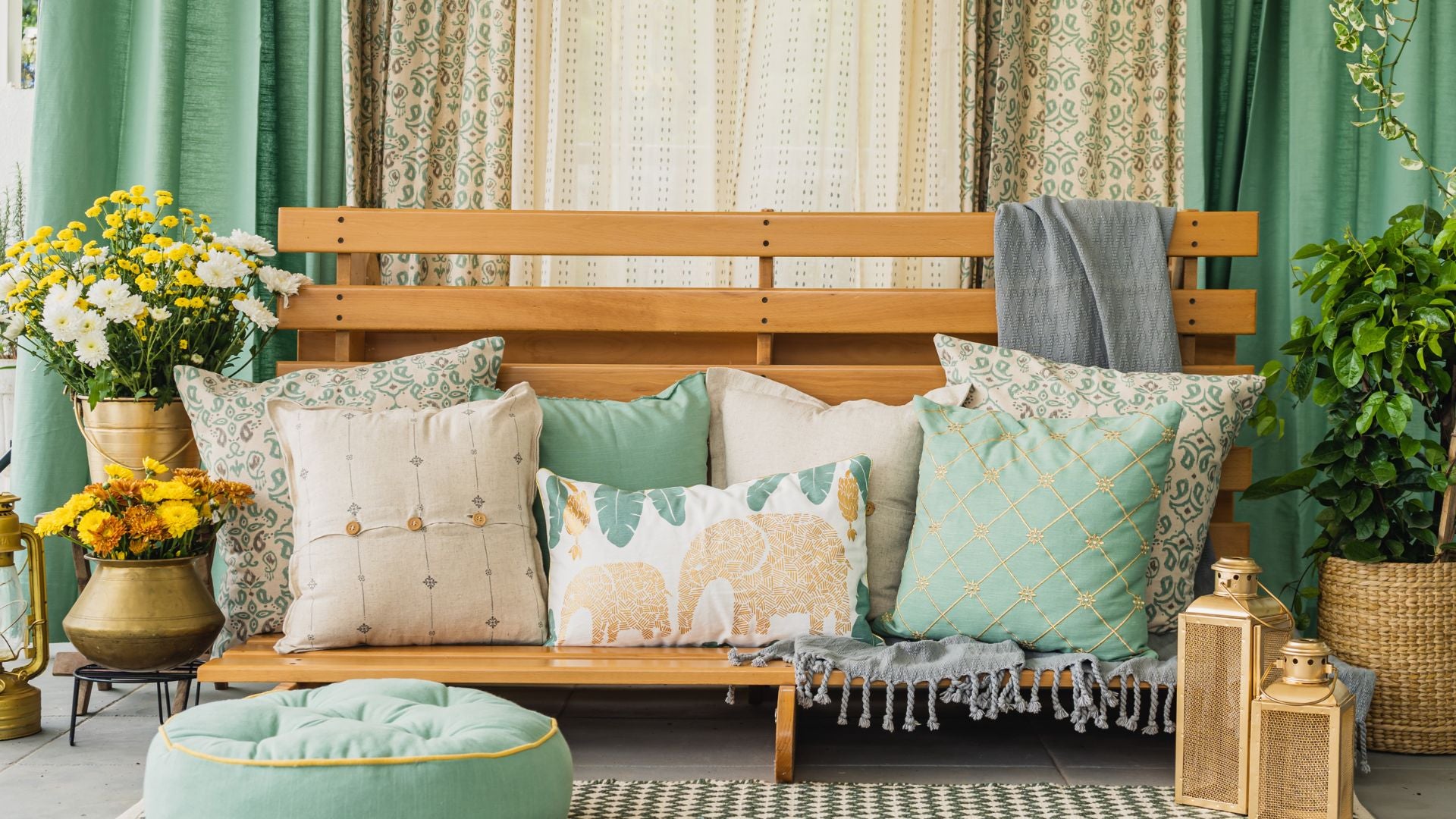Textile Trivia and History:
India has always been a treasure trove of textile traditions for centuries, and the Amber Trails Collection draws inspiration from some of the most iconic Indian textile and print styles. In this spotlight, let us take you on a journey through history and significance of these distinct styles of fabric and embroidery: Calico and Chintz, Kutch Embroidery and Patchwork and our Blue and White Curtain and Cushion collection, inspired by the Jaipur Blue Pottery.
1) Calico and Chintz:
Trivia: Calico, also known as ‘Calicut Cloth’, gets its name from the city of Calicut (Kozhikode) in Kerala, India. Believed to have been one of the earliest textiles traded by Europeans in India. The raw fabric was dyed and printed in bright hues.
Chintz is a woodblock printed, painted, stained, or glazed calico textile that originated in Golconda, Hyderabad, for export to Europe. The term “chintz” is derived from the Hindi word “chint”, meaning spotted or speckled.
History: Calico is characterized by its intricate floral and geometric patterns, often printed using the block-printing printing technique. This textile style dates to the 11th century and initially was known to have a lotus design printed on it.
Early Indian chintz, that is, glazed calico, with a large floral pattern, was primarily produced using painting techniques. Later, the hues, made of natural dyes, were applied by wooden blocks. Chintz fabrics were highly sought after and influenced European textile design. It’s a testament to India’s early global impact on the world of fashion.
Our design aspect: The intricate floral pattern reminiscent of the distinctive weave and print of the original Calico, is our inspiration. The floral patterns have been reimagined with fresh color's in our designs, creating a visual treat.
The vibrant hues and textures found in Chintz designs, guided our selection of color's and material. The bright overall floral patterns printed on a light background, is our inspiration.
 2) Crafts of Kutch:
2) Crafts of Kutch:
Trivia: Kutch embroidery hails from the Kutch region in Gujarat. It is known for its intricate and colourful thread work, inspired by nature and local culture.
History: This style has a rich history rooted in the nomadic communities of Kutch. It reflects the artistry and storytelling traditions of the region's people. Kutch embroidery has transcended generations and continues to be a symbol of creativity and craftsmanship. Kutch style is characterized by geometrically decorative designs and sometimes white three or five petal flowers, worked in tiny square chain stitching often outlined with white consecutively stitches.
Our design aspect: Inspired by the rich heritage of Kutch embroidery, we’ve embarked on a creative journey to craft something truly distinctive. We’ve woven the captivating stories of the Kutch embroidery into the very fabric of our collection, creating pieces that tell tales of tradition and artistry. We are captivated by the stitching style and incorporated some single line stitches into our products.

3) Patchwork Patterns
Trivia: One of the oldest and finest crafts of Gujarat and Rajasthan, patch work and appliqué use patches of fabrics stitched together to create floral and animal designs. A textile art form using pieces of fabric to create a larger design or pattern.
History: Earliest preserved pieces of patchwork are of the Middle Ages. Patchwork, also called piecing, is the process of joining strips, squares, triangles, hexagons, or other shaped pieces of fabric to create beautiful larger designs.
Our design aspect: We are inspired by the artistry and resourcefulness of the craft, the culture of upcycling and reusing, indirectly supporting sustainability. We’ve incorporated motifs, floral patterns, embroidery and distinctive colored fabric to give you a fresh, festive feel in our products.

4) Jaipur Blue Pottery
Trivia: Jaipur Blue Pottery is a unique ceramic art form known for its striking blue and white glaze. It originated in the city of Jaipur, Rajasthan. No clay is used: the 'dough' for the pottery is prepared by mixing quartz stone powder, powdered glass, Multani Mitti (Fuller's Earth), borax, gum and water. Blue pottery is beautifully decorated with the brush when the pot is rotated.
History: Jaipur blue pottery has strong influences of the Persian ceramic style, but it has developed its own designs and motifs. Inspired more from nature, the pottery is adorned with profusely animals, birds and flowers with a hint of Persian geometric design in the compositions. This style of pottery beautifully combines utility and aesthetics in its design.
Our design aspect: In essence, the design element of Jaipur blue pottery, with its timeless blue prints and motifs on a base of white, serves as the beating heart of our collection Amber Trials, infusing it with a timeless allure that pays homage to India’s heritage.
The AMBER TRAILS - Celebrating Togetherness, collection is a tribute to the remarkable Indian textile and print styles. Each piece in the collection is put together keeping in mind our rich history, culture, and craftsmanship to create designs of beauty that transcend time. By drawing our inspiration from these diverse traditions, we celebrate the artisans who have kept these traditions alive for generations.
As you explore the AMBER TRAILS collection, we hope you will discover the beauty of Indian textiles, steeped in history, and filled with stories waiting to be told. And take a piece of tradition to adorn your homes!!





